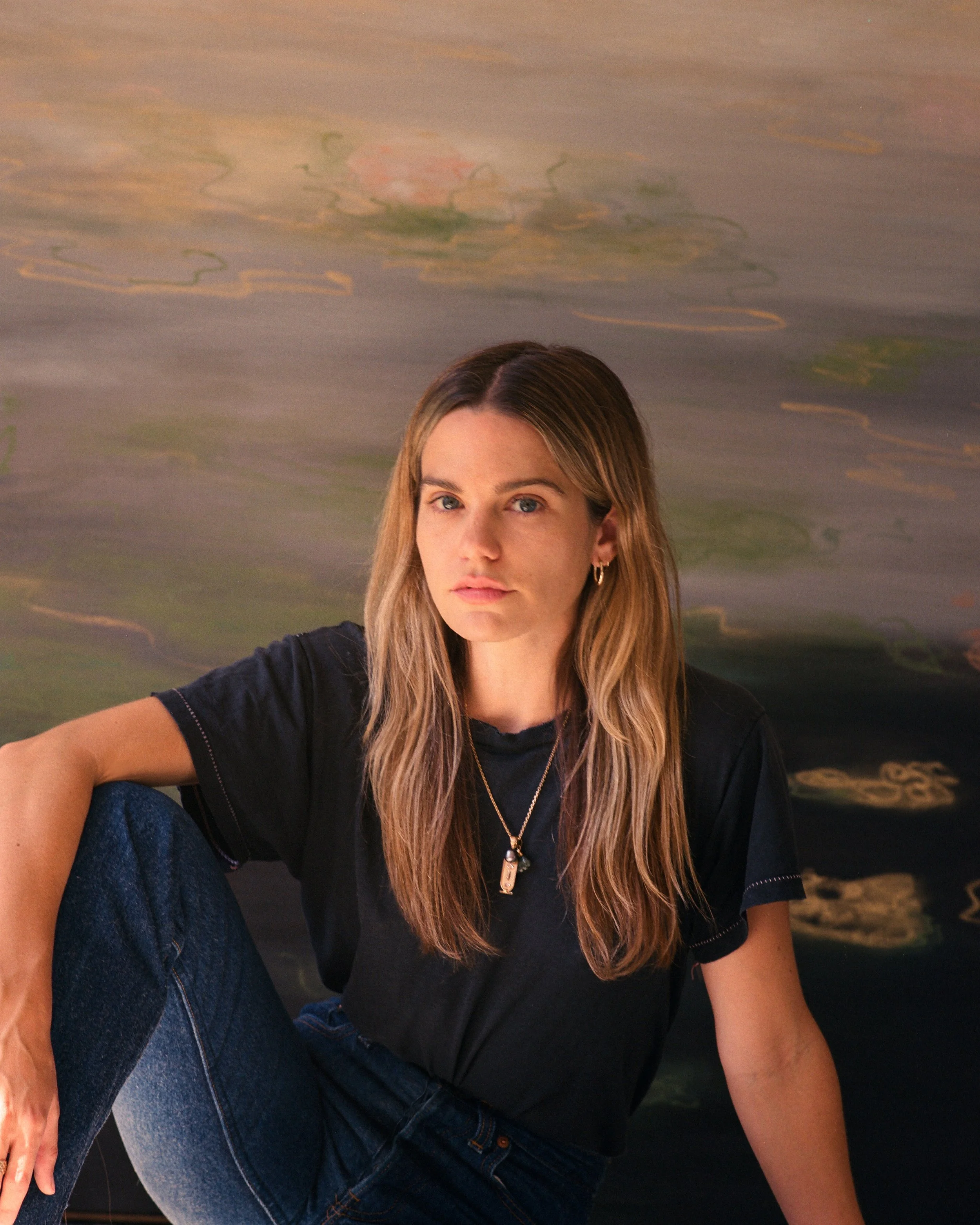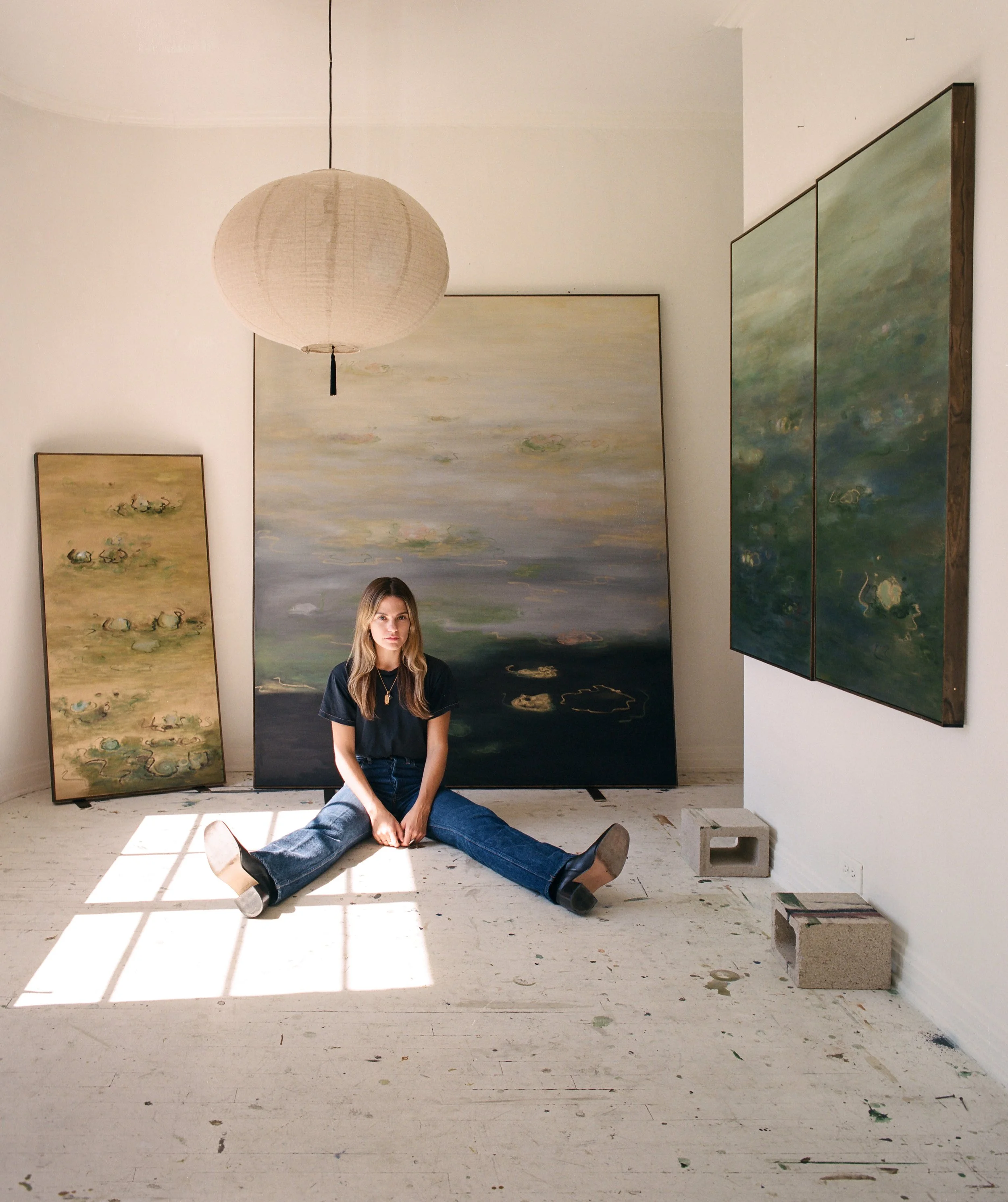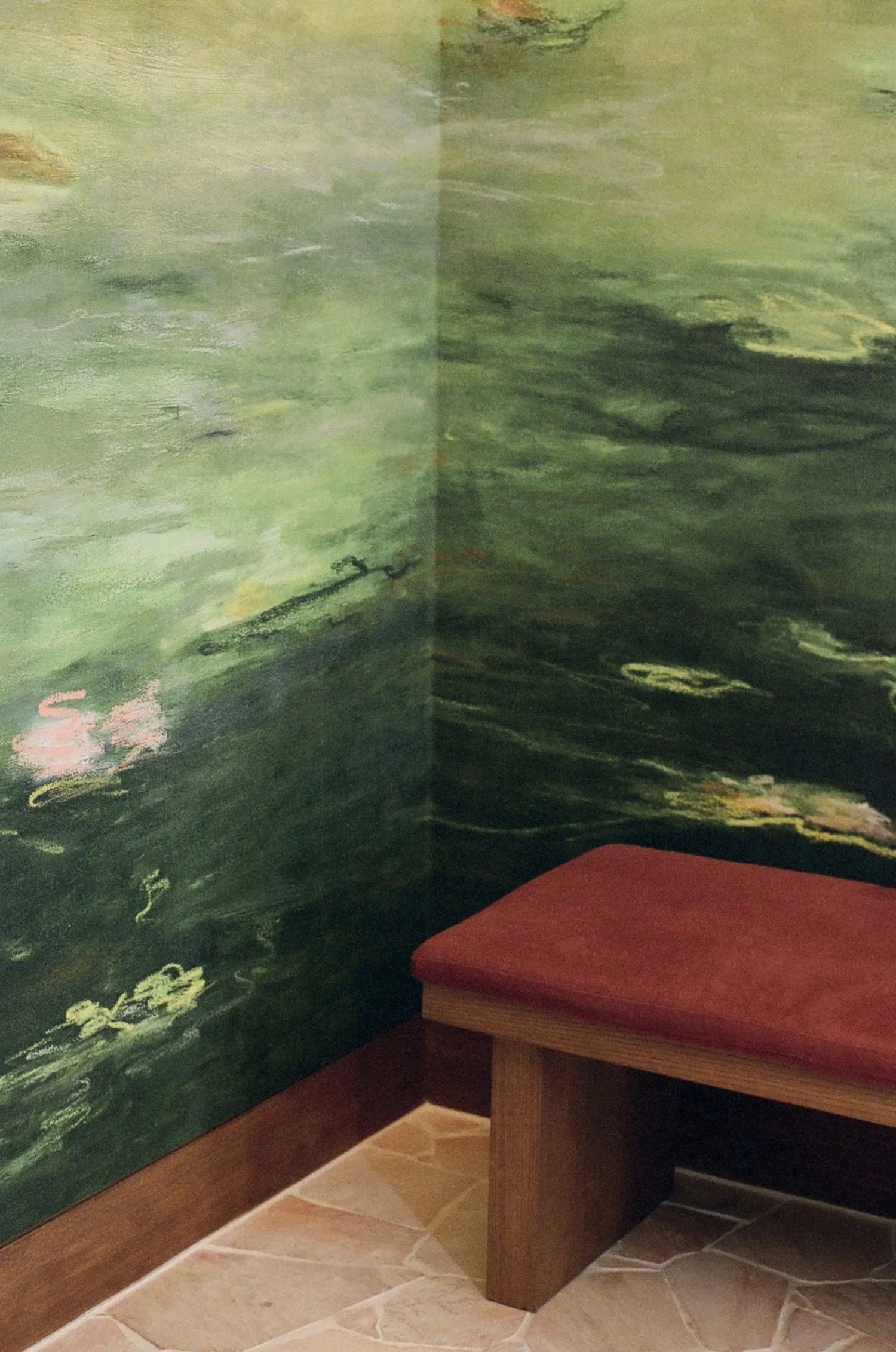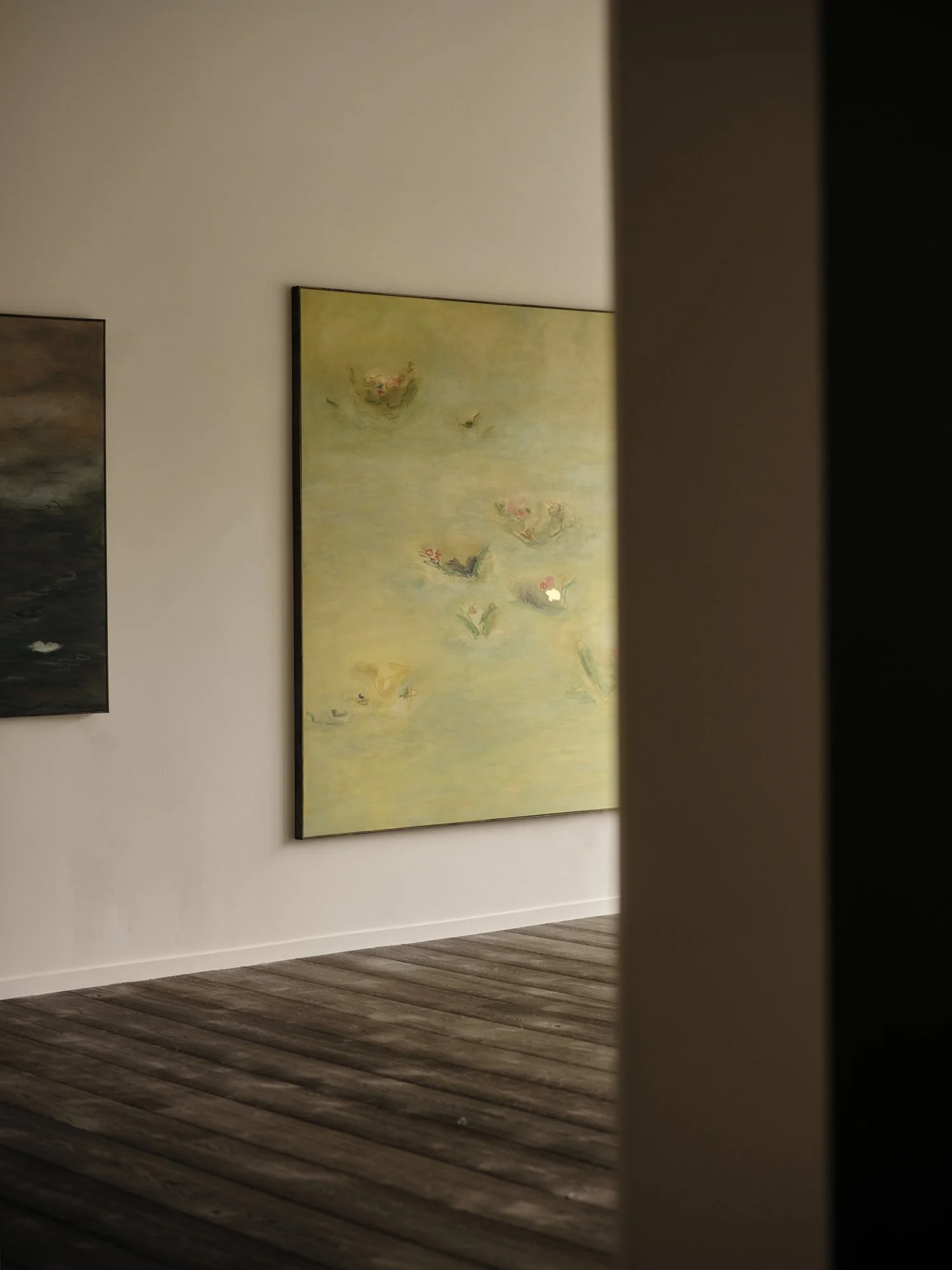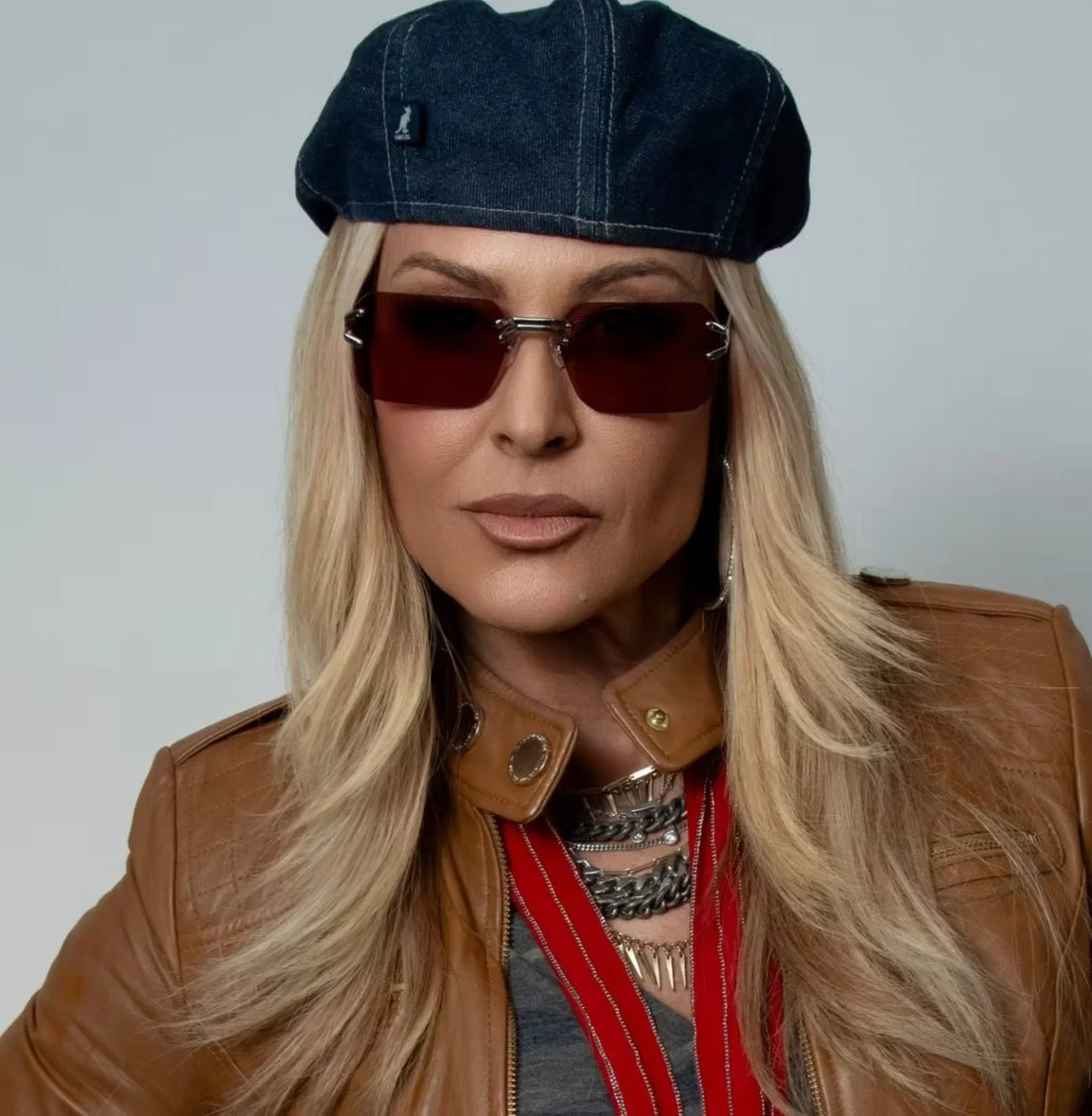The American Artist Unafraid to Reclaim Beauty
Photography by Drew Escriva, courtesy of Ash Roberts.
Ash Roberts
The American Artist Unafraid to Reclaim Beauty
By Bonnie Langedijk
Ash Roberts’ paintings are much more than just beautiful. The LA-based painter’s abstract landscapes in muted tones explore the fragility in nature and human life, capturing both the serenity and fleeting nature of the natural world. Growing up in a family of landscape designers, Roberts developed an early fascination with the cycles of growth and decay, which is central to her artistic practice. Her exploration of ideas of beauty, value and imperfection have led to collaborations beyond the art world, including a project with beauty brand Rowse, a commission by Festen Architecture for a 300 sq ft mural, which is on view in Soho, NYC. As well as representation by Francis Gallery in Los Angeles.
Roberts’ career took a significant turn when she met Rosa Park, founder of Francis Gallery, shortly after Park opened her gallery in LA. The two connected over their shared values and artistic philosophies. Their partnership flourished, and Roberts’ first public exhibition at Francis sold out within a week. Now, Roberts will be showing internationally for the first time in Of Merit, a group exhibition at Francis Gallery’s temporary London space from November 1-10, where her work will be displayed alongside John Zabawa. Further cementing her as one of contemporary art's most exciting emerging talents.
Robert’s mural commissioned by French architecture studio FESTEN, courtesy of Ash Roberts.
Photography by Drew Escriva, courtesy of Ash Roberts.
Bonnie: Landscapes have been a subject of interest for painters and artists for centuries. What made them your subject of choice?
Ash: What made me gravitate towards them, would probably be having family in landscape design. My family had a landscape design business, and I think very early on I learned poetry in nature very quickly whether it was conscious or subconscious. I would get trees for my birthday, that kind of thing. I use these elements in nature to communicate some heavier topics. These are more internal landscapes. It’s these motifs that were integrated in me from a very young age, to communicate and use as an analogy.
“I feel like it’s my DUTY as an artist to stand up because there are generations below you that need to see your work too so they can do their thing.”
When you first see your work, it doesn’t seem to be political or activist. For me, there's something serene about it. But of course, nature always has deeper meanings underneath it. Whether we're talking about something like climate change or a certain flower, a certain tree or a certain landscape can evoke a certain feeling oro meaning. How do you navigate creating something that, at least for me, is aesthetically beautiful while you're telling a story that maybe isn't?
Ash: Beauty is a tough subject in the art world. It's hard for me because I'm making the only thing I can make. I'm putting my soul on the canvas. I do have a certain taste level of course and it's probably going to show through. Like Cy Twombly or something like that. He had—I don’t want to say a good taste—no ego with his work, but when he was creating, his taste came out. I'm not necessarily sitting there thinking, that's not beautiful. But as far as having these dark and light forces, contradictions and climate change are all in there. There's a ton of collective shame right now about being human in general and what our species has done to the planet. The idea that we're capable of all this destruction while also being capable of a ton of healing. I'm hoping both of that's in there. A lot of times you'll see it gradient off, and as I see it, it's dark, murky times, but then there's this hope.
As humans, we always carry a certain duality. On the one end we want to be confronted with the reality we create, but we also want to escape it. I’m intrigued by what you said about beauty. First of all, what does beauty mean? And even talking about the art worlds, I still feel like there's very much a singular vision of what's accepted as “real” art.
Ash: I understand that beauty is not a talking point for art criticism. It has nothing to do with art criticism. Do you know Etel Adnan and her work at all? It's very colorful. She really says it best. She's a poet and a professor at Harvard and she said: “Beauty is like an inner sense and it makes us happy.” It’s not complicated at all, and we need it. Do you know Helen Frankenthaler works? This was an uphill battle for her entire career. It's considered bourgeois. I run into a lot of the same problems, but it's what we need in dark times. Beauty makes people happy. I feel like it’s my duty as an artist to stand up because there are generations below you that need to see your work too so they can do their thing.
There’s this archaic belief that for something to be good or intellectual, it can't be beautiful. I think about this a lot. It reminds me of the experience as a woman living in the world today. You have to take care of your appearance, but you can't be too pretty because you then can't be a serious or intellectual person. And it's the same with work. If it's too beautiful or just joyful, it can't have an importance to it.
Ash: That's why I think Etel is a great person to look up. She fought for brute beauty and poetry and ended up being very recognized by the art world. She fought that fight alongside many others and it's the same one I'm going to have to fight. My success has come from [my work] being beautiful. But also it's subjective. Some might not think it's beautiful, but unfortunately everyone's first words tend to be: “It's so beautiful”. And what am I supposed to do about it?
Do you find that a difficult compliment as an initial reaction?
Ash: Serene, that’s a big word too. I'd rather have that. It's more descriptive.
Photography by Drew Escriva, courtesy of Ash Roberts.
Robert’s mural commissioned by French architecture studio FESTEN, courtesy of Ash Roberts.
When you start a work, do you have an idea in mind of how it's going to turn out?
Ash: I have always been able to figuratively draw from a young age very well. You'll often see me blurring the lines between figurative and abstract because I'm more interested in communicating how something feels. A lot of times I'll show the bumps and bruises because I lean into imperfections. Life works like that as well. We go through these things. We have imperfections. So if I make an imperfection, that move might tell me where to go next, like a chess game. Once my life got a bit messy, I started to allow for the messiness.
So you work quite intuitively?
Ash: Oh, extremely. That's why the sketch will be more of remembering how that strange patina felt on that foggy day. It could be that abstract. It's a mood, not necessarily a figurative thing. Maybe that does come from being able to paint and draw figuratively very easily.
The harder path to take is to move away from where you’re naturally gifted. I can imagine it’s probably more difficult to let go of that.
Ash: Yes, and rebellious. It feels slightly more punk in a way.
I like it. Throughout your career you’ve worked with people and brands outside of the art world. The collaboration with ROWSE and architecture studio Festen for the Reformation store for example. How do you look at the intersection between art and other creative disciplines?
Ash: Being on different platforms through collaborations, helps you to not be such an elitist. The art world can be such an elitist world and I don't think that's necessarily fair. These collaborations can help you to not be too bourgeois.
Cross-disciplinary collaboration is an interesting concept. My background is in fashion, and fashion loves to dip into design, into art, to over intellectualize. I think art and design like to dip into fashion for exactly the opposite. It can be very transactional. For artists, I think much of the focus lies on ensuring they’re still viewed as a “serious artist”.
Ash: Yes. If we look back at people, like Warhol, they started in department stores. They started doing things like this Reformation project. How are we supposed to make money when we are just starting out? Unless you come from generational wealth, which I do not, my parents were school teachers and had a second landscape business. I think a serious artist is somebody who finds their way to make it happen.
But also if there's some sort of, as you said, if there's a certain lens or a certain value system off of which you make those decisions.
Ash: Exactly. Sustainable fashion for me is like that for example.
Group Exhibition- in this life(s) at Francis Gallery, featuring ‘verything In It's Place (2024) by Ash Roberts. Courtesy of Francis Gallery
Group Exhibition- in this life(s) at Francis Gallery, featuring Wisp (2024) by Mari-Ruth Oda and Chrysalis (2024) by Ash Roberts. Courtesy of Francis Gallery
You’re showing your work in London for the first time, and you also worked with gold pigment and gold leaf for the first time, right?
Ash: The show was made during a very strange time. I had lost a friend. The show was already scheduled and I was grieving a friend. I really had to push through and make the work, which was interesting because it's catharsis. It was easy to push through and release these feelings. But within that, there was this Robert Frost poem that I came across and it's called ‘Nothing Gold Can Stay’. It worked simultaneously with it and I assigned gold to all these paintings, whether it's gold pigment or gold leaf. It made for a very cohesive body of work. It's asking questions about value and what we assign value to and how you can communicate that. Gold seemed like a universal communication of value. I was at a place, with the loss of a friend, where I started questioning what I value. Where do I want to go next? And asking a lot of questions of where I am probably because of the grief. The paintings are named after pieces of the poem.
I’m sorry for your loss. Grief is still a very difficult emotion for many. But also in a way, death is the great equalizer, when you think about value.
Ash: Oh right. I actually hadn't thought of it as an equalizer. Rosa [Park] said that it would bring light to London. When the light hits it, you're getting a beam of light. It's so subtle.
Is there a certain starting point when you're working on something new? What’s your process like?
Ash: The process really starts with a feeling. It would be something I saw, something I felt. I'm trying to—like a journal entry—communicate something that I felt, saw or just had to express.
Are there works that now might be quite difficult to look at?
Ash: Oh, absolutely. Some of the pieces from the last show when the war had just started. There's this one piece called ‘Two Skies’. It's really gloomy and it was quite a hit. There were a lot of commissioner requests for it, and I was surprised. A lot of people in Berlin liked it, for example. Is that because of the gray there? Where this was such a dark piece for me, but then that part of the world might love it. There are these parallels between the climates that I'm creating, that are sometimes my own personal, landscape portraits, and the connections to them for people in certain areas in the world. It’s really fascinating.
Your starting point is your inner world vs. trying to please an audience. I think sometimes with creative people, whether you're a painter or a musician, it's dangerous to start thinking about the people consuming the work versus you making the work.
Ash: Yes, you are number one. It's like a mantra of the mind. It really matters if I like it and if I'm satisfied with it. The moment you try to please people, it doesn't work. You're done.
This interview has been edited and condensed for clarity.
